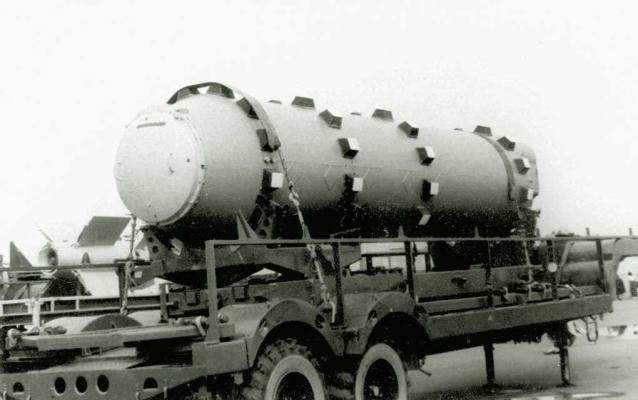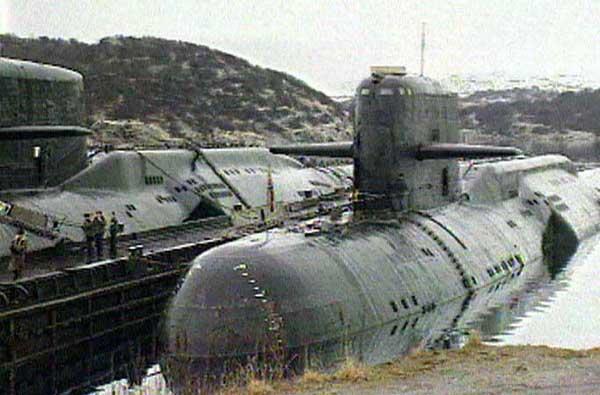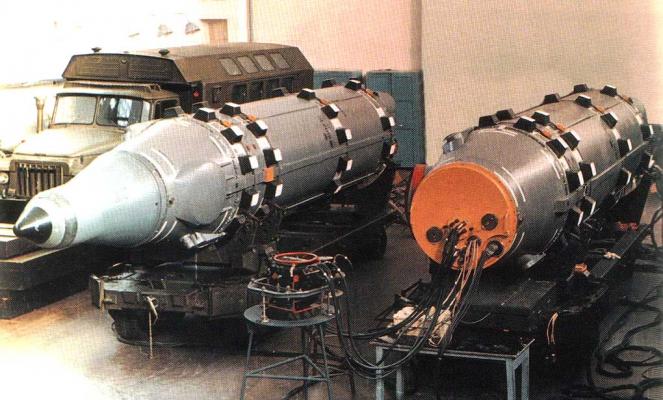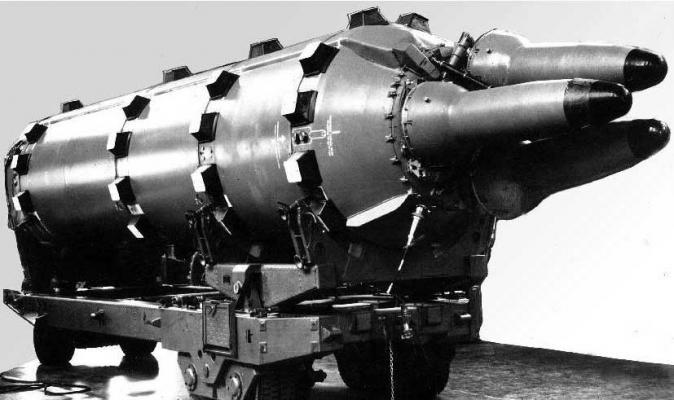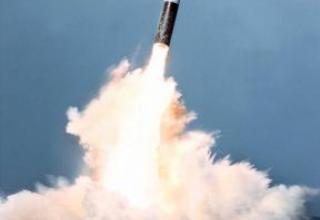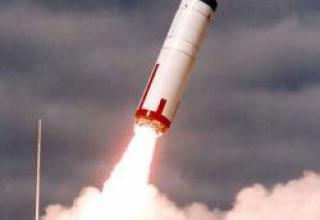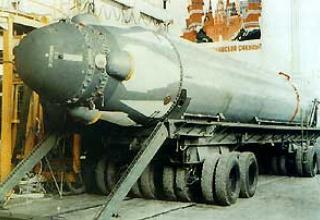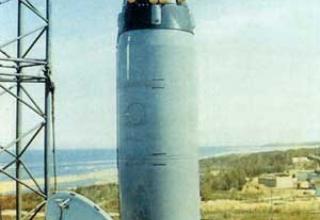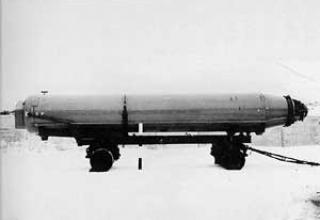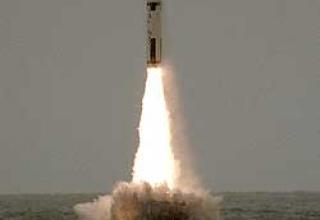The results obtained during the development of domestic submarine-launched ballistic missiles (SLBMs) of the first generation (R-11FM, R-13 and R-21) and their comparison with the American achievements in this field (Polaris A1, Polaris A2) led to the question of the need for a qualitative leap in the development of naval strategic forces. The main directions of their development were also clear: multiple increase in the number of missiles on a submarine; reduction of the size of missiles, warheads, launchers (missile launch systems) and missile silos; automation of the processes of missile maintenance during storage, prelaunch preparation and salvo shooting; all-round increase in the tactical and technical characteristics and performance characteristics of missiles and missile systems, etc. The purpose of developing new complexes was to ensure the development of the second effective component of the country's strategic missile forces - the marine strategic nuclear forces. To achieve this goal, significant progress was needed in the domestic maritime missile industry. The R-21 missile of the D-4 complex, which was adopted for service with the Russian Navy in 1963 and had a range of 1,400 km, was significantly inferior in its basic characteristics to the American Polaris A1 (1960, 2,200 km) and Polaris A2 (1962, 2,800 km) missiles. In addition, as noted above, the number of SLBMs on a typical American submarine missile carrier significantly exceeded that on a typical Soviet missile submarine, 16 versus 3. The development of both a new missile and a new nuclear submarine was needed to close the gap.
On April 24, 1962 the USSR Council of Ministers issued a resolution No. 386-179 on the development of a new R-27 missile of the D-5 complex for the armament of new nuclear missile submarines of the 667A project. SKB-385 was appointed head designer for the missile and the complex, while V. Makeev was appointed chief designer. P. The development of the missile control system was entrusted to NII-592 (Chief Designer - N.A. Semikhatov), and the placement of the complex on the submarine of project 667A was assigned to the Central Design Bureau-18 (Chief Designer - S.N. Kovalev).
The D-5 complex was tested in three stages. The first stage of in-situ tests of R-27 models was carried out from a flooded floatation stand of the PSD-5 in September 1965. Two launches were carried out. In January 1967, the tests of missile models in the Black Sea began from aboard the 613D5 submarine (the 613D7 prototype submarine re-equipped at Plant 444 in Sevastopol) in underwater position. The delay was due to the fact that the submarine was received by the customer only on December 23, 1965. On January 18, 1967 from the depth of 45 m with the boat speed of 3 knots, sea disturbance of 3 points and wind speed of 7-8 points the first launch of 4K10 missile mock-up was made. The last, sixth test, was conducted on August 10, 1967. At the same time the second stage was held. Flight tests from the ground stand at the Kapustin Yar test site were carried out from June 1966 to April 1967. Totally 17 launches were made, 12 of which were considered successful. Full-scale joint flight tests of the R-27 began in the Northern Fleet on the lead boat of project 667A - K-137 "Leninets" in August 1967. In total 6 launches were made. Starting from project 667A, all domestic nuclear submarines of the new projects were named "strategic nuclear missile cruiser". The D-5 complex with the R-27 missile was adopted for service on March 13, 1968 by Resolution of the Council of Ministers of the USSR No 162-164. Compared to the previous complexes with SLBMs for the Soviet Navy, the D-5 complex was a giant leap forward. As part of the Red Banner Northern Fleet, the first fleet to receive new ships, the RSFSN of project 667A entered the 19th and 31st divisions.
At the same time, compared to the SLBMs of the probable enemy, there was still a significant gap - the U.S. Navy has already received more advanced Polaris A3 (1964, 4,600 km, the world's first SLBM with 3 BB RFS) and Poseidon C3 (1971, 4,600 km, the world's first SLBM with 10 BB RFS). In 1968, the UK's Naval Strategic Nuclear Forces also became the second most powerful NATO country: the Polaris A3T SLBM (a Polaris A3 variant with enhanced resistance to PFCs) was adopted. In 1971, France's own M1 SLBMs (2,600 km) were also introduced, as it sought to pursue a nuclear policy independent of the US.
Under these circumstances, the Decree of the USSR Council of Ministers on the modernization of the D-5 complex was adopted on June 10, 1971. A goal was set to create two versions of the upgraded missile. The first version provided for equipping the missile with a head unit with three warheads, while maintaining the maximum range of the previous version and improving accuracy characteristics. The second option was to increase the firing range while improving accuracy. For the second version, a missile with a range of 3,000 km and a lightweight monoblock thermonuclear warhead of 1 Mt was created. The upgraded version of the complex received the designation D-5U, and missiles - R-27U.
Ship tests of R-27U missiles were held from September 1972 to August 1973. There were 16 launches, all recognized as successful. R-27U missile was adopted in service on January 4, 1974 by the Council of Ministers Decree № 8-5. The D-5U complex with R-27U missiles was equipped with nuclear submarines of project 667AU (4 pieces) under construction, as well as 667A project boats after modernization (8 pieces). In total at two shipbuilding enterprises (shipyards in Severodvinsk and Komsomolsk-on-Amur) from 1967 to 1972, 34 RSSCS of 667A project Navaga and 667AU project Navaga were put into operation (according to some data, RSSCS under construction in Severodvinsk had the designation Navaga, and in Komsomolsk-on-Amur - the designation Nalim). The missile carriers built under the latter project, in addition to improved missiles, had reduced noise, upgraded navigation and communication systems, etc. In addition, in 1981, SKB-385 completed modernization of the D-5 complex, associated with the replacement of the monoblock head unit with a monoblock HF from the D-5U complex, which allowed to increase the range of fire (D-5M complex). During the upgrade of the D-5 complex and R-27 missile, there were no specialized design modifications of the RPKSN systems and the rocket system placed on the RPKSN ("under the missile"). The algorithms of the digital computer systems and the databases related to the preparation of the flight mission and the operation of the new type of civil civil column were corrected. Ground equipment is mainly similar to that for the D-5 complex.
The modifications described above were not the only ones: the original CM decree of April 24, 1962 on the creation of the D-5 complex also provided for the creation of a missile with a homing warhead capable of engaging moving ships. The anti-ship version of the missile was designated R-27K (index GRAU 4K18). Tests of the complex with R-27K missile began in December 1970. The ground testing cycle at the Kapustin Yar Range included 20 launches (of which 16 were successful). A diesel-electric submarine - K-102 of project 629, with 4 missile silos on board, was re-equipped to carry missiles under pilot project 605. The first launch from the submarine was carried out in December 1972. And in November 1973 the tests were completed with a two rocket volley. Totally 11 launches were made, 10 of them were considered successful. During the last launch the target vessel was struck by a direct hit of the guided block. In 1974, the missile was accepted for pilot operation.
In the 1990s, work was carried out to develop carrier rockets based on submarine decommissioned ballistic missiles. The Zybyi launch vehicle was created on the basis of the R-27. The missiles were used in research experiments requiring the creation of microgravity. The weightlessness period lasted from 17 to 24 minutes. A payload of up to 1.5 m3 in volume could be delivered to the suborbital orbit of Zybykh. The mass of the payload could reach 650 kg with a maximum orbit altitude of 1800 km or 1000 kg with an orbit altitude of 1000 km. Three launches were made. On December 1, 1991 the "Sprint" module developed by SKB-385 together with NPO "Composite" was launched. The module was designed to test technologies for producing superconducting materials and carried 15 exothermic furnaces on board. On December 9, 1992 and December 1, 1993 the Ether module with 80 kg of Medusa biotechnological equipment was launched. The module, developed in conjunction with the Space Biotechnology Centre, was designed to study the technology for cleaning biological and medical preparations using electrophoresis in zero gravity conditions.
The D-5 complex was operated from 1968 to 1998. In total about 1800 missiles were produced, 492 missiles were launched, 429 of which were recognized as successful. The maximum number of launches was 58 in 1971. This is a kind of record for Soviet and Russian submarine ballistic missiles. The complex also holds a record for the average annual number of launches - 23.4. 161 launches were made while operating the D-5U complex, of which 150 were successful. The last launches of R-27 and R-27U missiles under combat training plans were made in 1988. After that the launches were made only for research purposes. During the period of operation, 8 missiles were fired twice (once each in the Northern and Pacific fleets) in one salvo. All the launches were found to be successful. During the entire period of operation, more than 10,000 rocket loadings and offloads were carried out, and 590 combat patrols were carried out by boats armed with RSM-25 in various areas of the world's oceans.
During the period of operation there were several accidents with the destruction of missiles. Six people were killed and one RPSCN was lost. During loading and unloading, the missile fell from a height of 10 m to the berth. An oxidizer tank was destroyed. Two people from the loading lot died from the impact of oxidizer vapor on unprotected respiratory organs. Three times a missile was destroyed in the mine of a boat on combat duty. In 1973, the K-219 boat, located at a depth of 100 m, caused a false triggering of the irrigation system with an open shaft drainage valve and a manual valve on the jumper between the boat's main drainage line and the shaft's drainage pipeline. The pressure of 10 atmospheres destroyed the rocket tanks. When the mine was drained, the rocket fuel burst into flames, but the timely activation of the automatic irrigation system prevented further development of the accident. The boat safely returned to its base. On the exercise "Ocean-76" on the boat K-444 conducted pre-launch preparation of three missiles. Two missiles were launched and no third missile was fired. Pressure in the rocket tanks was released before the boat surfaced due to a number of human errors. The pressure in the intake water destroyed the missile's tanks, and when the mine surfaced and drained, the oxidizer leaked into the mine. Thanks to the skilful actions of the personnel, no emergency situation occurred. The third accident also occurred on the boat K-219 on October 3, 1986. For unidentified reasons, when diving after a communication session, water began to flow into the missile silo. The crew tried to switch off the automatics and drain the water using non-standard means. As a result, the pressure was first equalized with the outboard and the rocket tanks collapsed. Then after draining the mine, the fuel components caught fire. The switched off irrigation automatics did not work, and there was an explosion at a depth of 85 meters. The explosion blew off the lid of the missile silo (see photo) and started a fire in missile compartment 4. During the fire and smoke in missile compartment 4 and 5, 3 people were killed, including the commander of BC-2. The crew failed to extinguish the fire with their own forces, the rocket carrier lost power and stroke. Later, during the procedure of decommissioning the GEU, 1 more person died. The attempt to organize the towing of the RSCC to Cuba with the help of the Soviet ships that came up failed. The bays began to be filled with outgoing water, and the personnel, after more than 3 days of heroic struggle for survivability, had to gradually leave the emergency rocket carrier, which sank on October 6 at a depth of 5.65 km in the area of 1000 km north-east of Bermuda. This catastrophe, taking into account the Chernobyl radiation catastrophe that occurred only 5 months before and the radiation psychosis that appeared in the world, struck a new serious blow to the international prestige of the USSR. The operating experience of the RSM-25 missiles has been analyzed and taken into account in the development of new complexes. As a result, no further modifications of the SLBMs were made during their operation.
The first missile carriers of Project 667A began to withdraw from the fleet under the Soviet-American arms reduction agreements as early as 1978 in order to maintain the number of AB carriers at a certain level. Some of the missile carriers were converted to special-purpose submarines (2 units, projects 09774 and 09780), some were transformed into submarines with strategic Grenade SLCMs (3 units, project 667AT). One rocket carrier was upgraded under Project 667M to test strategic SLCM "Meteorite". Others were put into conservation with the missile compartment cut out and then disposed of. The R-27U modification was withdrawn from service even before the collapse of the Soviet Union, in 1989. Other modifications of the missile were removed from service in Russia as part of the START-1 treaty. According to the September 1990 memorandum, 192 nuclear warheads were deployed on the R-27 in the USSR (192 SLBMs, 16 RPKSNs at 3 bases ["Yagelnaya" at KCF, "Fisherman" and "Pavlovskoye" at KTOF]; 142 more SLBMs at the same bases were kept non-deployed). In addition, 173 non-deployed SLBM-25 SLBMs were stored at 3 storage sites for SLBMs ("Okolnaya", "Revda" and "Nenoksa") and at the Pashino SLBM conversion and liquidation site. As of July 1997, there were 16 deployed warheads (1 RPKSN) on the R-27. By 1998, all R-27 missiles had been decommissioned.
The relatively short range of the Soviet missiles made it necessary for Soviet SSBNs to patrol in the zones of operation of powerful anti-submarine defense forces of the US Navy and NATO (primarily, off the East and West coasts of the US), which significantly reduced the combat stability of Soviet missile carriers (especially in the 80s). However, despite a number of shortcomings, the Soviet Union managed to create a fairly effective strategic missile system, thanks to which the Soviet ICNs reached a qualitatively new stage in their development. The appearance in the Navy of a significant number of quite modern RSCCs with a significant number of SLBMs per each significantly increased the probability of a guaranteed retaliatory strike, primarily given the accuracy of the new missiles on the so-called "soft" targets - political, economic and industrial centers. A number of new technical solutions have been tested on the R-27 for the first time. The use of these developments on subsequent missile systems made it possible to completely eliminate the US backlog in this class of weapons, and in a number of areas (astroinertial command and control systems, intercontinental-class SLBMs, etc.) and outrun the US.
R-27 missile had "western" designation SS-N-6 Serb mod.1, modifications of R-27U - SS-N-6 Serb mod.3 and mod.2, R-27K - SS-NX-13. The Project 667A (AU) boosters were code-named Yankee.
Composition:
In developing the R-27 missile family (see the scheme), a number of innovative solutions were applied, which determined the appearance of SKB-385 missiles for a long time:
- maximum utilization of the entire internal volume of the missile to accommodate the fuel components - no traditional break-down into compartments, placement of the marching engine in the fuel tank (the so-called "recessed" scheme), use of a common bottom of the fuel tank and oxidizer, placement of an instrument compartment in the front bottom of the missile;
- an all-welded hermetic case made of wafer shells of the chemically milled plates, the material for which was aluminium-magnesium alloy AMg-6;
- reduction in the volume of the air bell due to successive starting of the steering engines first and then the marching engine ("dynamic bell");
- joint development of the rocket and the elements of the rocket-launch system - the elimination of aerodynamic stabilizers and the use of belt rubber-metal shock absorbers;
- factory refuelling of missiles and amputation of fuel components.
The measures taken allowed to sharply increase the average density of the missile layout, thereby reducing its dimensions, as well as reducing the required volume of the shaft and tanks of the ring gap. Thus, in comparison with the R-21 missile, the firing range has increased by 1.8 times, the missile's length has been reduced by one third, the mass of the launcher has been reduced by more than 10 times, the missile's mass has been reduced by almost one third, the volume of the ring gap has been reduced by almost 5 times. The load on a boat per missile (the mass of missiles, launchers, missile silos and tanks of the ring gap) decreased three times.
The P-27 missile (see diagram) was designed in a single-stage design with a monoblock detachable head end. The casing of the all-welded, airtight missile was made of "waffle" cloths obtained by chemical milling of aluminum-magnesium alloy АМг-6 plates. Initially, 5-6-fold excess of the thickness of the original metal sheet over the thickness of the resulting shell was achieved. Subsequently, with the application of mechanical milling, this index was increased to 9. The outer surface of the shell was protected with a heat-resistant coating on the basis of asbotexolite.
The missile was equipped with a liquid rocket engine 4D10 developed by OKB-2 (later - Chemical Engineering Design Bureau, Chief Designer A. M. Isaev), which consisted of two blocks. The engine consisted of a marching block with a thrust of 23 tons and a steering block with two chambers with a total thrust of 3 tons. The ZHRD used self-inflammable fuel components. Unbalanced dimethylhydrazine (NDMG) was used as a fuel, and nitrogen tetraoxide (AT) was used as an oxidizer. In connection with the use of self-ignition fuel components to prevent accidents when liquid fuel components enter the mine when the missile is depressurized, there were automated systems of irrigation, gas analysis and maintenance of the microclimate in given parameters. The fuel components were supplied by turbo-pump units. The marshal engine operated under the scheme with afterburning of oxidative gas. The engine traction was regulated by the fuel consumption regulator. The steering unit was made according to the scheme without afterburning, with gas generator producing gas with excess fuel. The traction of the steering unit was controlled by a regulator on a common oxidizer line. For the first time in world practice, the engine was placed in a fuel tank - the so-called "recessed" scheme. When installing the engine were used only permanent connections - welding and soldering. The engine became unattended and unverifiable. Starting the engine was carried out from a single pyroelectron, and the output was controlled by its own automatics. The oscillating chambers of the steering engine were mounted on the conical bottom of the fuel tank, at an angle of 45° to the missile stabilization planes. The steel engine elements were attached to the aluminium housing using special bimetallic adapters. A common two-layer bottom of the fuel and oxidizer tanks was used to reduce empty fuel cavities in the missile. This made it possible to eliminate the inter-tank compartment. Another innovative solution was the factory refueling with subsequent "ampulsification" of the tanks by welding the filling and drain valves. Combined with works on increasing corrosion resistance of materials, tightness of seams and joints, it allowed initially to set the service life of rockets in the charged state 5 years. And later it was possible to bring it to 15 years.
Elements of inertial control system for the first time in USSR (for SLBM) were placed on gyrostabilized platform. The control system equipment was placed in the sealed volume formed by hemispherical upper bottom of the oxidizer tank. This made it possible to exclude the classic instrument compartment from the missile design.
The R-27 was equipped with a monoblock detachable head unit weighing 650 kg (see photo). The power of the nuclear charge placed on it is 1 Mt. For the first time in the practice of SKB-385, an explosive device was used to separate the main part from the missile - a detonating elongated charge of a cumulative type based on a brilliant explosive. When firing at the maximum range the KVO was reached - 1.9 km. The warhead was created by the Research Institute-1011 (Chelyabinsk-70), chief designer Klopov L. F. The main difficulty was the need to create a warhead that would be approximately twice as light as the previous one. The charge of the two-stage circuit was designed by KB-11 (Arzamas-16), Chief Designer Negin E. A. Charging tests were conducted on Novaya Zemlya in 1966. Small-size automatics were developed for the new warhead. The bottom of the head unit served simultaneously as a low-voltage unit housing. Special concerns were caused by high-altitude blast sensors. Using an automated system of pre-start preparation, the designers were able to implement amendments to the setting of high-altitude detonation sensors depending on the specific conditions of the firing and the characteristics of the target. The aluminium-magnesium alloy head end housing differed from the previous ones in that it had a double cone shape with a rounded nose. The asbestolite coating and the resulting detached aerodynamic jump protected the charge and the automatics from overheating in the final section of the warhead trajectory.
Two versions of combat equipment have been developed for R-27U missile.
The first version provided for equipping the missile with a dividing head unit with three warheads (see photo) with a capacity of 200 kt each, with a maximum firing range of 2500 km. The split MS was of the so-called "scattering type" - the warheads did not have individual pointing at targets. At the end of the active range, the blocks would "expand" in different directions at low relative speeds. The booster was mounted at the junction, which was identical to the front joint of the R-27 missile body, through appropriate adapters. The adapter for the RRG contained a mechanism to deflect the ABs from their transport and flight positions for subsequent deployment at close aiming points.
The second option provided for an increased range of fire with a simultaneous increase in the missile's accuracy. For the second version, a missile with a range of 3,000 km and a lightweight monoblock thermonuclear warhead of 1 Mt was created (see photo). In both versions, the CEP of 1.3 km was achieved for the R-27U missile.
R-27K anti-ship missile (index GRAU 4K18) was equipped with the second stage with a liquid propellant rocket engine developed by KB-2 (Chief Designer A. M. Isaev). To preserve the dimensions of the missile, the size of the first stage was reduced, which ultimately led to a reduction of the maximum range to 900 km. The head end is monoblock (see photo), nuclear, 0.65 Mt. Guidance in the passive section was provided by the passive radar CNS, with the signal processed by the onboard digital computer system. Initial data for firing were provided by the RS satellite system or the Success-U aircraft system. Data processing on the "Kasatka" reconnaissance ship equipment made it possible to determine the coordinates of a group of ships with an accuracy of 25 km. According to calculations, during the prelaunch preparation the target location could change up to 150 km, so the second stage was controlled by double activation of the second stage engine in the extraatmospheric flight area. Initially, the option of additional trajectory correction in the atmospheric section and equipping the missile with a low-power warhead was also considered, but later this option was abandoned in favour of a purely ballistic one, with an increased power warhead.
The type of missile launch is the so-called "wet", from a previously flooded mine (see photo). In the lower part of the P-27 was installed a special adapter, with which the missile docked to the launch table. In the process of preparing the rocket for launch, the rocket tanks were inflated. Water was supplied to the mine and the pressure was equalized with the overboard. The cover of the missile silo was opened. To reduce the hydraulic impact that occurs when the engine is launched in a rocket-filled mine, the engine was launched into an airtight volume formed by the adapter and the starting table. The technology for creating a "dynamic bell" was developed. At the beginning of the launch, the steering engines were launched into the "gas bell" formed by the adapter. Then, at the beginning of the rocket movement, the marching engine was launched and gradually put into full thrust mode. At further movement of the rocket on it began to act a moment from the raging water flow. Reduction of loads acting on the structure of the missile leaving the mine contributed to the pre-inflating tanks and located on the rocket belt itself special rubber-metal shock absorbers. Transition to the elastomeric horizontal cushioning of the SLBMs with the increased "energy intensity" of the rubber-metal shock absorbers, their stepwise power characteristics in combination with the increased allowable overloads on the missile and the placement of shock absorbers on the missile allowed to sharply reduce the circular clearance. In addition, the shock absorbers began to act as guides, and the traditional guides, together with the rods located on the adapter (did not participate in the flight), provided only loading and unloading of the missile. Elimination of the rocket's impact with the mine during the launch and compensation for the water flow from the RPSCN's stroke speed were provided by the use of a gas-operated rudder mounted on the marching LRD.
Maintenance and procedures for prelaunch and launch of missiles were maximally automated. The systems were remotely controlled and monitored from a single shipboard system for routine and prelaunch missile maintenance. Integrated regulatory checks, prelaunch and launch management were carried out from the missile control desk. Input data for the use of both missile and torpedo weapons were produced by the first domestic combat information and control system "Tucha" (Chief Designer - R.R. Belsky) equipped with a specialized computer (Chief Designer - Y.A. Khetagurov). Besides, "Tucha" collected and processed information about the environment and solved navigation tasks.
Navigational equipment of the new submarine ensured confident navigation and launching of rockets in polar areas. The missiles were launched only from an underwater position, from a depth of no more than 50 m, the speed of the boat to 4 knots and the sea disturbance no more than 5 points. The time of missile prelaunch preparation was 10 minutes. The interval of firing missiles in one salvo - 8 seconds. Calculations showed that as the rockets in the salvo are fired the RPKSN should gradually pop up and after the launch of the 4th rocket in the salvo exit from the permissible "corridor" of the launch depths. Initially, the launch of a set of 16 SLBMs was carried out in four four rocket volleys at intervals: between the 1st and 2nd volleys and the 3rd and 4th volleys - 3 minutes (in order to return the ship to its original depth), between the 2nd and 3rd volleys - no more than 35 minutes (for pumping water from the tanks of the ring gap in the missile silos, as well as for the differentiation of the ship). The modified equipment then allowed for real combat firing of two eight-missile volleys, with the interval between volleys 1 and 2 not exceeding 20 minutes, which, compared to previous capabilities, significantly reduced the disguise of the RSCC. For the first time in the world such a salvo was fired on December 19, 1969 from the K-140 rocket launcher. The firing sector for Project 667A was 20°, the latitude of the launch point should not exceed 85°.
Characteristics:
| Range of fire, km | 2500 (R-27U - 3000 with monoblock HF; 2500 with HF) |
| Maximum altitude, km | 620 |
| Height at the end of the active section, km | 120 |
| Speed at the end of the active section, km/s. | 4.4 |
| The time of the active section, s | 128.5 |
| Speed of meeting of PPP to target, km/sec | 0.3 |
| KVO, km | 1.9 ( P-27U - 1.3 ) |
| Dimensions, m: - length - diameter |
8.89 1.5 |
| Start mass, t | 14.2 |
| Mass h.p., t. | 0.65 |
| HF power, Mt. | 1.0 (Р-27U - 1.0 or 3х0.2 ) |
| Dimensions FPU, m: - height - diameter |
10.13 1.7 |
Testing:
As of 01.01.1950, the factory batch of 230 shells was completed and sent to the Pavlograd test site.
In November 1949, pre-factory tests of 34 shells were carried out together with the fuse B-377 during which cases of missiles were revealed.
Special tests carried out to determine the causes of deficits showed that the most probable cause was an increased release of unburned reactive charge particles at the end of the active section of the trajectory.
In order to eliminate this phenomenon, in December 1949 a bench-top refinement of the engine was started with regard to aperture enhancement and ensuring that the powder charge was fixed in the chamber. After the end of the bench work and experimental firing for checking the reinforced aperture, the factory batch of projectiles was to be equipped with modified apertures on site and presented for factory tests in February 1950.
Sources:
- СКБ-385, КБ машиностроения, ГРЦ "КБ им. Академика В. П. Макеева" под общ. ред. В. Г. Дегтяря. М.: Государственный ракетный центр "КБ им. академика В. П. Макеева"; ООО "Военный Парад", 2007
- В. Ильин, А. Колесников. Подводные лодки России. М.: АСТ, 2004.
- Е.А.Шитиков "Ядерное противостояние: К истории создания боеголовок морских баллистических ракет". Вопросы истории естествознания и техники, №1, 1998.
- И.И. Величко, Е.М. Кутовой "Баллистические ракеты с ядерными боеголовками для подводных лодок" (http://flot.com/)
- Е.М. Мнев, В.Т. Чемодуров "О научном обеспечении подводного старта баллистических ракет" (http://flot.com/)
- Н.А. Семихатов, В.В. Чеботарев "Создание систем управления баллистических ракет подводных лодок" (http://flot.com/)
- Е.А. Шитиков "Ядерное оружие" (http://flot.com/)
- А.К. Чернышев "ВНИИЭФ-ДОСТОЯНИЕ И ГОРДОСТЬ РОССИИ" (http://vniief.ru/)
- И.А. Андрюшин, А.К. Чернышев, Ю.А. Юдин "Укрощение ядра. Страницы истории ядерного оружия и ядерной инфраструктуры СССР" / С., С.: Красный Октябрь, 2003.
